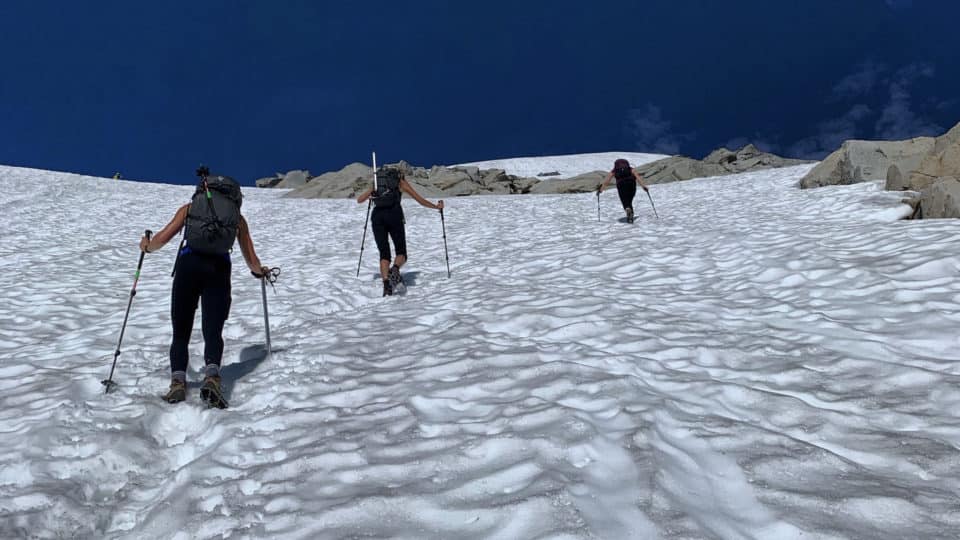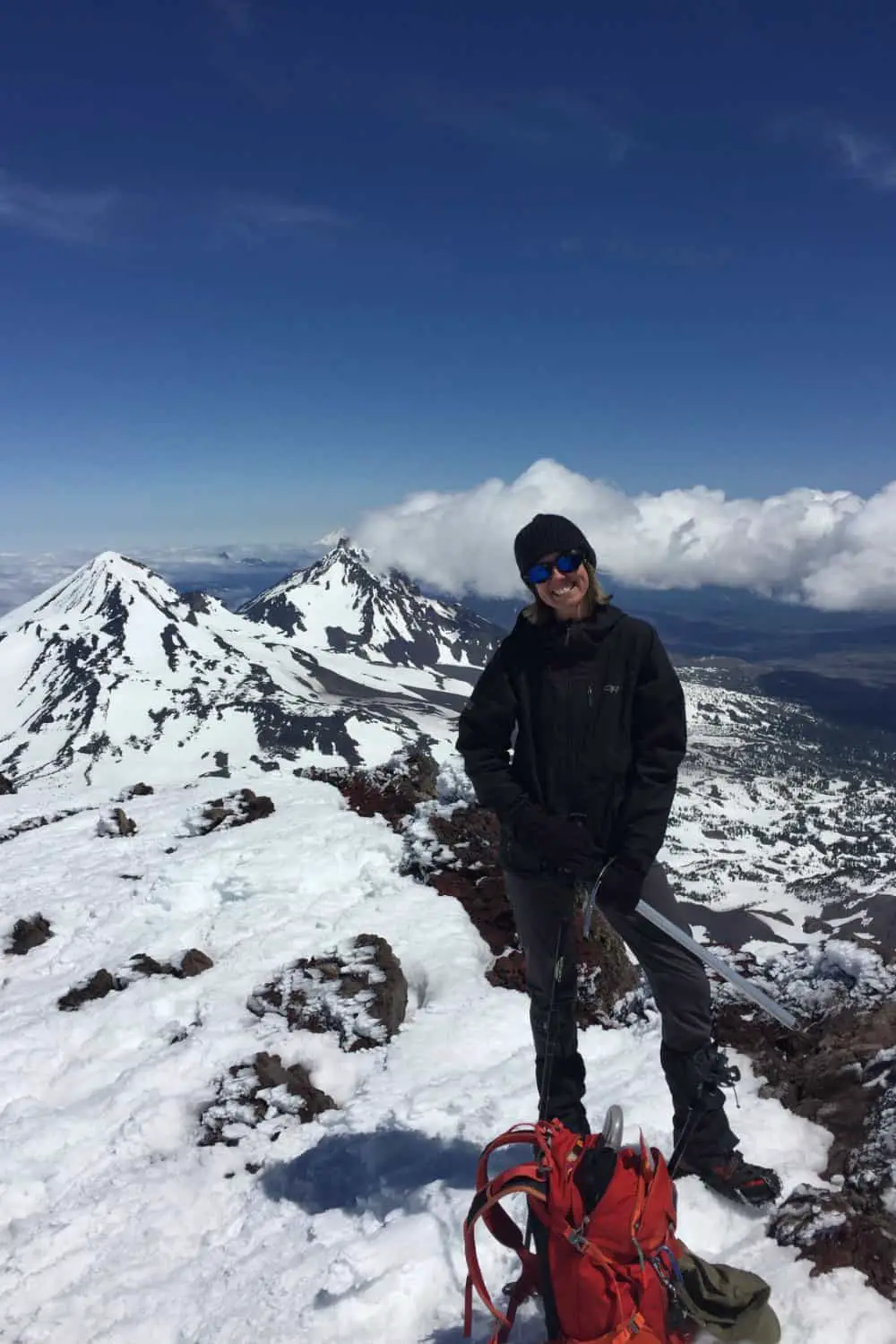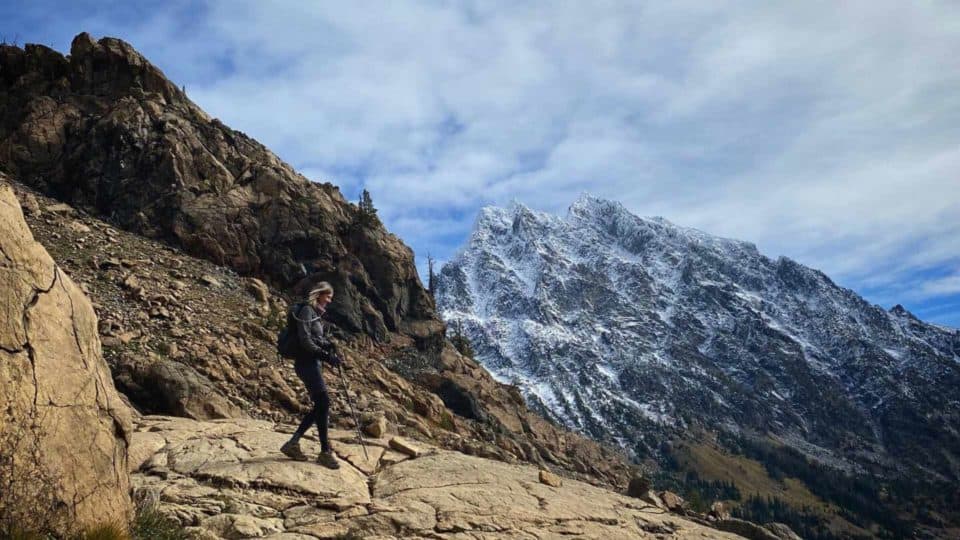Trekking poles are standard equipment for many hikers, but you’ve probably noticed that not everyone uses them, and might be wondering: Should I? Is it really best in the long run (no pun intended) for my knees to use them? Or is it better not to use them so I can develop and strengthen my own agility and balance? So to pole or not to pole, that is the question. And there isn’t really a right or wrong answer. That is, unless specific conditions call for it or your body needs them. So, why not just strap a pair to your backpack just in case?
When Should I Use Hiking Poles?
Some people swear by poles while others see them as an impediment to developing your own balance and strength. One thing I’ve found in my time out here on the trails is there are always extreme opinions or practices on each end of the spectrum and a lot of conversations that sound like arguments take place about the “right” way to hike, whether it’s the fast-and-light crew vs. the expedition types, the solos vs. the buddy system people, or the boots vs. trail runners folks. Poles are another of these topics where you’re bound to generate some lively conversation if you ask whether you should hike with them or not. There are a few situations that no one will argue you on (scrambling? Of course no poles; crossing a river on wet rocks? Most people would say yes) but for the rest of it, for the average day hike, you’re going to get a whole lot of opinions either way. Ultimately it comes down to your comfort level, your body, your mood, your route. Sometimes they are a safety item (steep slopes, narrow catwalks, icy trails) and sometimes a comfort item (high mileage days on gentle hills for someone with a bum knee or two). Let’s take a closer look at the factors that will contribute to your decision-making process.
Deciding to use trekking poles while you hike will depend on several factors, including:
- The terrain
- The weather
- Your body
- The activity
The Terrain
When traveling on rough, uneven terrain, where the trail is a medley of pebbles-dirt-rocks-gravel-mud and there’s a good chance you might encounter water crossings, poles are a really great idea. In a situation like that, you can use them for balance and stability as well as poking at the depth of mud or water before you step in. If there is any off-trail travel or bushwhacking, you can use your poles to push branches out of your way instead of breaking them off. Having two additional points of contact can give you that extra push when going up rocky trails that feel like a staircase built for someone a few inches taller than you.
In varied-terrain situations, I bring mine even if I only use them for the steepest part of the descent. They don’t weigh much, they attach to my pack, and I’d rather have them and not use them, then not bring them and wish I had. There’s a popular hike in these parts that’s very steep and very rugged (see the article on Mailbox Peak), and I almost always bring my poles there, in case I have jello legs on the way down and want a little extra insurance, because it’s all roots and rocks and the trip down can be more like a controlled fall as you lose 4000 feet in just over two miles. I have used them on the way up a few times too, when I’m training with a heavy pack or if it’s snowy. Speaking of snow…
The Weather
Anytime there’s snow, I bring poles with me. If it’s more than a few inches deep, you’ll want snow baskets on the ends of your poles to prevent them sinking to the ground with each step (pulling them up and out is energy best spent elsewhere). On frequently-traveled trails, the snow gets packed down to a hard icy surface, and you could find yourself feeling a bit slippy-slidey without them, even with microspikes on. If you are going to be on steep slopes in the snow, you’ll want them to help give you traction and torque on the way up, and stability and brakes on the way down.

A recent example of bringing poles for short term snow usage was yesterday on Mount Si. This is a mountain I’ve hiked dozens and dozens of times that isn’t particularly difficult or rugged, but it got a little dusting of snow the day before, just the top half-mile or so, but it’s a heavily-trafficked trail and temps weren’t high enough to soften it, so it would be pressed down to ice from foot traffic and super slippery. Could I have made it without poles or spikes? Sure, slowly and awkwardly. But since I’d rather not look like any more like a giraffe doing the Charleston like I already do, I brought one pole, and threw my spikes on for all of about fifteen minutes. But here’s the thing about gear and safety and winter hiking, is if I can use things to keep travel time to a minimum, I’m exposed to the cold for less time and keep my heart rate and body temp steady, rather than walking uphill at a 2.5 mph pace for 90 minutes only to stop and carefully tiptoe and hug trees for a half mile that winds up taking an hour. On the descent, after the snowy part, I just folded my pole back up and lashed it to my pack and jogged down. I didn’t notice the extra weight of the pole but I did notice that my time was on par with my summer time despite the snowy icy conditions on the upper mountain.
Body Mechanics
There are a couple schools of thought on the way poles do or don’t help your body. Taking terrain, snow, injury, and other extenuating circumstances out of the picture, just purely from a body mechanics standpoint, here are some of the conversations going around:
- Pro-Pole: The folks who use poles on the regular always rave about how much they reduce impact on the joints, especially knees but also hips and ankles.
- Anti-Pole: They see poles as an impediment to gaining a more agile, lithe sense of balance, as well as detracting from developing good posture and strong ankles, knees, and quads.
The research on joint health and trekking poles is overwhelmingly in favor of using them, as they do reduce the jarring blow that reverberates through your whole body with each step taken. If you have knee, ankle, hip, or back problems your medical team has likely already advised you to use them as they allow you to strengthen your leg muscles and get the aerobic benefits of hiking while softening the impact.
When I mentioned the purists on the far end of the spectrum, be aware that there are those people who see poles as a crutch and think they are cheating your body out of developing agility and balance. Which I understand, and I go without poles as often as possible in order to give my ankles and core and hips the chance to get stronger and get that muscle memory locked in, but I will use them when safety, speed, or comfort level dictate that their use is the wisest choice for the situation. However, the notion that poles are like training wheels on a bike doesn’t take into consideration those times when you need the extra points of contact for safety. It’s a good example of taking what you need from each school of thought and tailoring it to fit you and your needs, always keeping safety first and then employing a whole lot of trial and error for the rest.
The Type of Activity
The type of activity you are doing will determine whether a pole makes sense or not. Trail running? Usually not (though some do carry a light collapsible pole or two that they can attach to their hydration packs if they are going to be running a few steeper hills). Snow travel? Usually yes, especially if you’re on a heavily populated trail that has the potential to get so compressed it turns to ice. Any hike with a heavy pack, yes. Anything that has sustained slopes near 30º, yes. If there are substantial water crossings that may involve balancing on wet rocks or walking across a river on a log, you bet. Long distances, anything over say 10 miles, it’s probably smart to give your joints a little break. But if I’m just out on my local state park trails that are well-groomed, not steep, and constructed with proper bridges, and I don’t have much more weight than my water on me, I don’t normally bring poles. My rationale is that I use them so much on other hikes that I should skip them when it’s safe to go without, and make that my time to strengthen my legs and ankles and core while developing a more confident, practiced sense of balance.
Other Considerations
Calorie Burn: It’s not my reason, but many people do use hiking for weight loss and fitness. Most studies show about a 20% increase in calorie burn when hiking with poles over not with poles, and using poles greatly enhances the full-body muscle-building and aerobic benefits of hiking. With trekking poles, hikers use upper body muscles they don’t ordinarily engage, like biceps, triceps, latissimus dorsi, and pecs. Regularly engaging these muscles with every swing-and-plant of your trekking poles strengthens and tones and makes for a more comprehensive workout, enhancing the aerobic benefit of hiking.
Injury Prevention: Poles can prevent injury by preventing falls and wear and tear on the joints. Giving yourself two extra points of contact makes you a more stable and efficient hiker, easily able to correct small slips and stumbles. Trekking poles also prevent minor pain as well as major repetitive stress injuries. Long days on the trail with or without a heavy pack places a tremendous amount of stress on the ankles, knees, and hips. If you feel pain at or below your knees on steep descents, and at or above your knees during steep ascents, you might want to try poles and see if you feel a difference on the short term; long term benefits have been proven. Poles recruit other muscles to help propel you up and down hills, and transfer the weight and impact of each step more evenly throughout the body, reducing the strain that would ordinarily be absorbed exclusively by the joints and muscles in the lower body alone.
A Splint: Poles can make a nice impromptu splint should the occasion ever arise. Whether collapsing them down to their shortest and tying a shirt around them for a broken arm or extending and securing them tight with those extra layers for a broken leg, you have a makeshift first aid item with you when you hike with poles.
Wildlife: You can try to look big for a cougar or fling a snake off the trail with poles, and though it’s rare you’d need to use them as self-defense, or that they would be super effective, they can make you feel like you have some protection. I know first hand that they will deter low-flying owls and hawks curious about your beanie.
Best Trekking Poles For Women
Trekking poles made for women specifically tend to have smaller hand grips but otherwise function the same. Three companies that offer stellar examples of poles made just for women are Black Diamond, Leki, and REI:
Black Diamond Trekking Poles For Women
Black Diamond makes some excellent trekking poles designed specifically for women. My two favorite Black Diamond women’s poles are the Distance FLZ Trekking Poles/Women’s and the Trail Ergo Cork Trekking Poles/Women’s.
The Black Diamond Distance FLZ Trekking Poles/Women’s are an awesome set of poles that are very lightweight and super-compact. They don’t weigh much so are great to bring on a trek “just in case.”
[amazon box=”B077SFPBKZ” template=”horizontal”]
The Black Diamond Trail Ergo Cork Trekking Poles/Women’s are very comfortable and are great all-around alpine poles. In addition, the grip is wrapped with 100% natural cork that is super-absorbent which works especially well in hot or humid conditions when you may have sweaty hands.
[amazon box=”B07YLSVVQP” template=”horizontal”]
Leki Trekking Poles For Women
Leki also makes some excellent trekking poles tailored specifically for women. My favorite Leki women’s trekking poles are the Women’s Legacy Lite Cor-Tec AS and the Women’s Micro Vario Carbon.
The Leki Women’s Legacy Lite Cor-Tec AS Trekking Poles are lightweight, comfortable, and compact. They also have smaller grips which are perfect for our typically smaller hands and helps prevent wrist fatigue on longer treks. Also, as with Black Diamond’s Ergo Cork poles, the Legacy Lite’s grip is wrapped in natural cork material to help keep them from slipping out of your hands when wet.
[amazon box=”B07MVKQJV5″ template=”horizontal”]
The Leki Women’s Micro Vario Carbon Trekking Poles are super-comfy and super lightweight. I mean, really light … they weigh only 230 grams (0.5 lbs) per pole. Also, the soft, lightweight grip extends down the pole so I can easily “grip-down” to effectively shorten the pole-length for incline changes. A little on the expensive side, but I love these.
[amazon box=”B07MVL2VF7″ template=”horizontal”]
REI Trekking Poles For Women
REI sells a variety of trekking poles for women from Black Diamond, Leki, and others. In addition, they have their own self-branded basic offering, REI Co-op Flash Carbon Trekking Poles/Women’s, that happen to be quite popular in the hiking community. They aren’t aren’t fancy, but they are utilitarian, lightweight, and reasonably priced for the beginning to novice hiker. And, I see a lot of them on the trail.
If I Had To Choose Just One …
All of the hiking poles I’ve discussed above are excellent, top of the line, and will satisfy even the most picky hikers. However, if I had to choose just one set of women’s hiking poles, it would be the Leki Women’s Micro Vario Carbon Trekking Poles. I started out with a pair of Black Diamond Distance FLZs but snapped one in half one snowy day while walking too fast on a talus field…the pole slid down between two rocks, I kept going, it stayed in place and snapped in two. After that, I got a cheap pair of Cascades at Big 5 (literally they were $24) figuring if I was going to be breaking them, I should probably not spend massive bucks on them. And then a couple years after that, I tried a friend’s Lekis and immediately felt the difference. I decided that one broken pole over thousands of miles of hiking didn’t qualify as a reason to not buy quality poles and ordered my own that same day. The hand grips are a perfect size, they are light, and they collapse easily. Because of how unobtrusive they are, I bring them along far more often than I normally would, something I’m sure my joints appreciate. What I love most is that they are light but strong, and I can trust them to help me tackle absolutely any peak I throw their way.
Sources
Black Diamond: Company Website
Leki: Company Website
REI: Company Website

Wendy Harrington is a California native who has lived in a small town at the foothills of the Cascade Mountains in Washington state since 2001. Her love of trail running and peakbagging has led her to summit all five Washington volcanoes, climb to the high points of three states, and put nearly a thousand miles a year on her boots. Her loves include ridgelines, saddles, granite, one-day pushes on big mountains, anything volcanic, long solo days, and objectives that push limits and test endurance.

